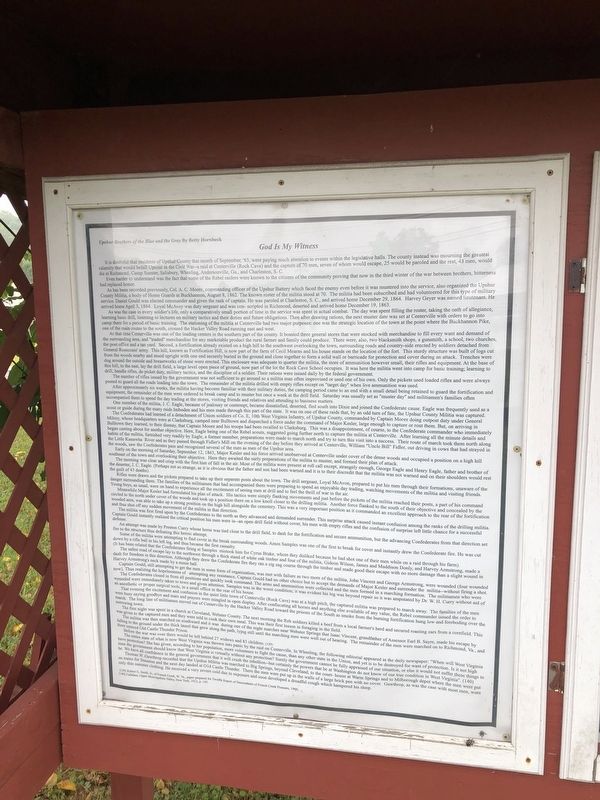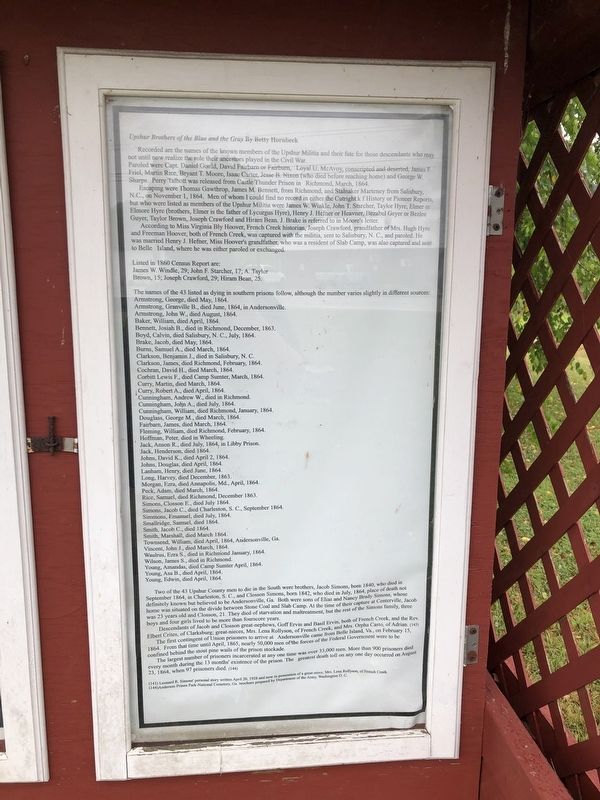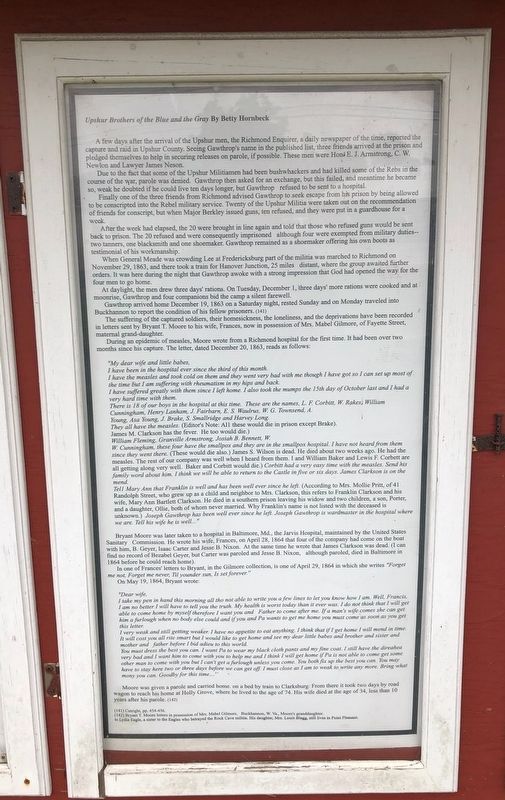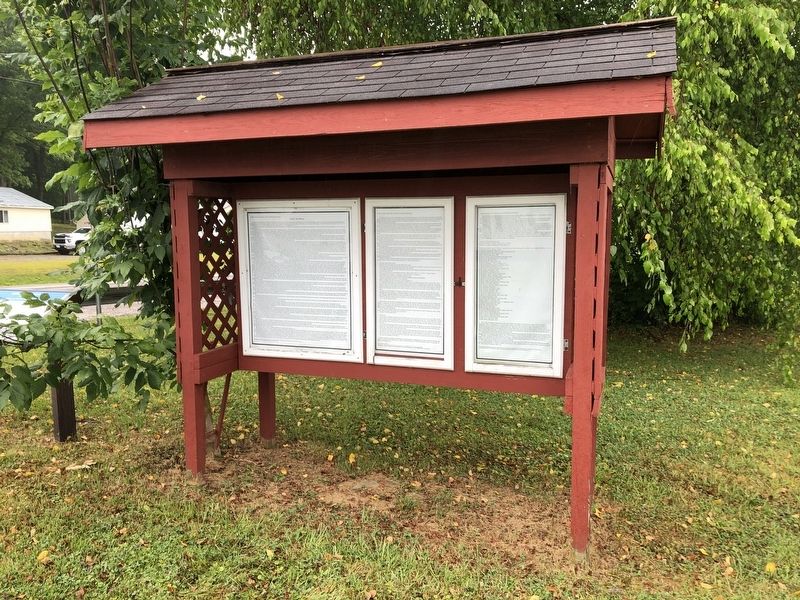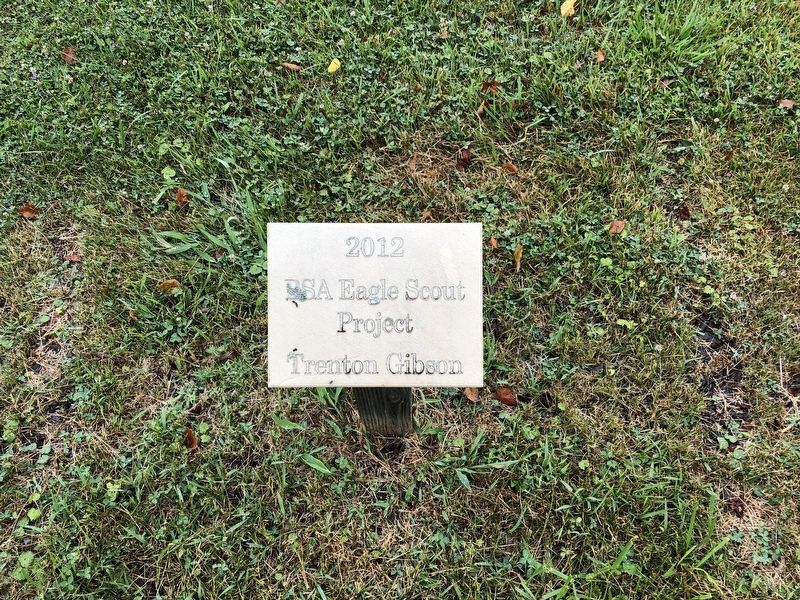Crawford in Upshur County, West Virginia — The American South (Appalachia)
God Is My Witness
Upshur Brothers of the Blue and the Gray By Betty Hornbeck
It is doubtful that residents of Upshur County that month of September, '63, were paying much attention to events within the legislative halls. The county instead was mourning the greatest calamity that would befall Upshur in the Civil War--a raid at the Centerville (Rock Cave) and the capture of 70 men, seven of whom would escape, 25 would be paroled and the rest, 43 men, would die at Richmond, Camp Sumter, Salisbury, Wheeling, Andersonville, Ga., and Charleston S.C.
Even harder to understand was the fact that some of the Rebel raiders were known to the citizens of the community proving now in the third winter of the war between brothers, bitterness had replaced honor.
As has been recorded previously, Col. A.C. Moore, commanding officer of the Upshur Battery which faced the enemy even before it was mustered into the service, also organized the Upshur County Militia, a body of Home Guards at Buckhannon, August 8, 1862. The known roster of the militia stood at 70. The militia had been subscribed and had volunteered for this type of military service. Daniel Gould was elected commander and given the rank of captain. He was paroled at Charleston, S.C., and arrived home December 29, 1864. Harvey Geyer was named lieutenant. He arrived home April 3, 1864. Loyal McAvoy was duty sergeant and was con-scripted in Richmond, deserted and arrived home December 19, 1863.
As was the case in every soldier's life, only a comparatively small portion of time in the service was spent in actual combat. The day was spent filling the roster, taking the oath of allegiance, learning basic drill, listening to lectures on military tactics and their duties and future obligations. Then after drawing rations, the next muster date was set at Centerville with orders to go into camp there for a period of basic training. The stationing of the militia at Centerville had two major purposes: one was the strategic location of the town at the point where the Buckhannon Pike, one of the main routes to the south, crossed the Hacker Valley Road running east and west.
At that time Centerville was one of the leading centers in the southern part of the county. It boasted three general stores stores that were stocked with merchandise to fill every want and demand of the surrounding area, and "traded" merchandise for any marketable product the rural farmer and family could produce. There were, also, two blacksmith shops, a gunsmith, a school, two churches, the post office and a tan yard. Second, a fortification already existed on a high hill to the southwest overlooking the town, surrounding roads and country-side erected by soldiers detached from General Rosecrans' army. This hill, known as Fortification Hill,
The number of rifles issued by the government was not sufficient to go around so a militia man often improvised or used one of his own. Only the pickets used loaded rifles and were always posted to guard all the roads leading into the town. The remainder of the militia drilled with empty rifles except on "target day" when live ammunition was used.
After approximately six weeks, the militia having become familiar with their military duties, the camping period came to an end with a small detail being
One member of the militia, J.C. Eagle, because of jealousy or contempt, became dissatisfied, deserted, fled south into Dixie and joined the Confederate cause. Eagle was frequently used as a scout or guide during the many raids Imboden and his men made through this part of the state. It was on one of these raids that, by an odd turn of fate, the Upshur County Militia was captured.
The Confederates had learned of a detachment of Union soldiers of Co. E., 10th West Virginia Infantry, of Upshur County, commanded by Captain Moore doing outpost duty under General Milroy, whose headquarters were at Clarksburg, camped near Bulltown and dispatched a force under the command of Major Kesler, large enough to capture or rout them. But, on arriving in Bulltown they learned, to their dismay, that Captain Moore and his troops had been recalled to Clarksburg. This was a disappointment, of course, to the Confederate commander who immediately began casting about another objective. Here, Eagle being one of the Rebel scouts, suggested
Early on the morning of Saturday, September 12, 1863, Major Kesler and his force arrived unobserved at Centerville under cover of the dense woods and occupied a position on a high hill southeast of the town and overlooking their objective. Here they awaited the early preparations of the militia to muster, and formed their plan of attack.
The morning was clear and crisp with the first hint of fall in the air. Most of the militia were present at roll call except, strangely enough, George Eagle and Henry Eagle, father and brother of the deserter, J.C. Eagle. (Perhaps not so strange, as it is obvious that the father and son had been warned and it is to their discredit that the militia was not warned and on their shoulders would rest the guilt of 43 deaths).
Rifles were
Meanwhile Major Kresler had formulated his plan of attack. His tactics were simply flanking movements and just before the pickets of the militia reached their posts, a part of his command circled to the north under cover of the woods and took up a position there on a low knoll closer to the drilling militia. Another force flanked to the south of their objective and concealed by the wooded area, was able to take up a strong position on the high hill alongside the cemetery. This was a very important position as it commanded an excellent approach to the rear of the fortification and thus shut off any sudden movement of the militia in that direction.
The militia was first fired upon by the Confederate to the north as they advanced and demanded surrender. This surprise attack caused instant confusion among the ranks of the drilling militia. Captain Gould instantly realized the critical position his men were inan open drill field without cover, his men with empty rifles and the confusion of surprise left little chance for a successful defense.
An attempt was made by Preston Curry whose horse was tied close to the drill field, to dash for the fortification and secure ammunition, but the advancing Confederates from that direction set fire to the structure thus defeating this heroic attempt.
Some of the militia were attempting to find cover in the break surrounding woods. Amos Samples was one of the first to break for cover and instantly drew the Confederate fire. He was cut down by a rifle ball in his left leg, and thus became the first casualty.
(It has been related that the Confederates firing at Samples mistook him for Cyrus Brake, whom they disliked because he had shot one of their men while on a raid through his farm).
The safest road of escape lay to the northwest through a thick stand of white oak timber and four of the militia, Gideon Wilson, James and Maddison Donly, and Harvey Armstrong, made a dash for freedom in this direction. Although they drew the Confederate fire they ran a zig zag course through the timber and made good their escape with no more damage than a slight wound in Harvey Armstrong's neck made by a minie ball.
Captain Gould, still attempting to get the men in some form of organization, was met with failure as two more of the militia, John Vincent and George Armstrong, were wounded (four wounded now). Thus realizing the hopelessness of attempting any resistance, Captain Gould had no other choice but to accept the demands of Major Kresler and surrendered the militia--without firing a shot.
The Confederates closed in from all positions and quickly took command. The arms and ammunition were collected and the men formed in a marching formation. The militiamen who were wounded were immediately taken to town and given attention. Samples was in the worst condition; it was evident his leg was beyond repair so it was amputated by Dr. W.H. Curry without aid of an anesthetic or proper surgical tools, in a small office in the rear of his house.
That evening the excitement and confusion in the quiet little town of Centerville (Rock Cave) was at a high pitch, the captured militia was prepared to march away. The families of the men were busy saying goodbye and tears and prayers were mingled in open display. After confiscating all horses and anything else available of any value, the Rebel commander issued the order to march. The long line of militiamen moved out of Centerville by the Hacker Valley Road toward the prisons of the South as smoke from the burning fortification hung low and foreboding over the sorrowing town.
The first night was spent in a church at Cleveland, Webster County. The next morning the Reb soldiers killed a beef from a local farmer's herd and secured roasting ears from a cornfield. This was given to the captured men and they were told to cook their own meal. This was their first lesson in foraging in the field.
The militia was then marched on southward and it was during one of the night marches near Webster Springs that Isaac Vincent, grandfather of Assessor Earl B. Sayre, made his escape by falling to the ground under the thick laurel that grew along the path, lying still until the marching men were well out of hearing. The remainder of the men were marched on to Richmond, Va., and there entered Old Castle Thunder Prison.
Before the war was over there would be left behind 27 widows and 83 children.
The entire state of what is now West Virginia was thrown into panic by the raid on Centerville. In Wheeling, the following editorial appeared in the daily newspaper: "When will West Virginia have protection? She has given, according to her population, more volunteers to fight the cause, than any other state in the Union, and yet is to be destroyed for want of protection. It is not high time the government should know that West Virginia is virtually without any protection? Surely the government cannot be fully appraised of our situation, or else it would not suffer these things to be. We have all confidence in the general government that it will crush the rebellion--but certainly the powers that be at Washington do not know of our true condition in West Virginia".
Thomas W. Gawthrop recorded that the Upshur Militia was marched to Big Springs, beyond Cleveland, to the court-house at Warm Springs and to Milborough depot where the men were put on trains for Staunton and the next day landed at Old Castle Thunder. There the men were put up in the walls of a large brick pen with no cover. Gawthrop, as was the case with most men, wore only thin summer clothing. He received a very severe cold due to exposure and soon developed a dreadful cough which hampered his sleep.
A few days after the arrival of the Upshur men, the Richmond Enquirer, a daily newspaper of the time, reported the capture and raid in Upshur County. Seeing Gawthrop's name in the published list, three friends arrived at the prison and pledged themselves to help in securing releases on parole, if possible. These men were Hon. E.J. Armstrong, C.W. Newlon and Lawyer James Neson.
Due to the fact that some of the Upshur Militiamen had been bushwhackers and had killed some of the Rebs in the course of the war, parole was denied. Gawthrop then asked for an exchange, but this failed, and meantime he became so, weak he doubted if he could live ten days longer, but Gawthrop refused to be sent to a hospital.
Finally one of the three friends from Richmond advised Gawthrop to seek escape from his prison by being allowed to be conscripted into the Rebel military service. Twenty of the Upshur Militia were taken out on the recommendation of friends for conscript, but when Major Berkley issued guns, ten refused, and they were put in a guardhouse for a week.
AFter the week had elapsed, the 20 were brought in line again and told that those who refused guns would be sent back to prison. The 20 refused and were consequently imprisoned although four were exempted from military duties--two tanners, one blacksmith and one shoemaker. Gawthrop remained as a shoemaker offering his own boots as testimonial of his workmanship.
When General Meade was crowding Lee at Fredericksburg part of the militia was marched to Richmond on November 29, 1863, and there took a train for Hanover Junction, 25 miles distant, where the group awaited further orders. It was here during the night that Gawthrop awoke with a strong impression that God had opened the way for the four men to go home.
At daylight, the men drew three days' rations. On Tuesday, December 1, three days' more rations were cooked and at moonrise, Gawthrop and four companions bid the camp a silent farewell.
Gawthrop arrived home December 19, 1863 on a Saturday night, rested Sunday and on Monday traveled into Buckhannon to report the condition of his fellow prisoners.
The suffering of the captured soldiers, their homesickness, the loneliness, and the deprivations have been recorded in letters sent by Bryant T. Moore to his wife, Frances, now in possession of Mrs. Mabel Gilmore, of Fayette Street, maternal grand-daughter.
During an epidemic of measles, Moore wrote from a Richmond hospital for the first time. It had been over two months since his capture. The letter, dated December 20, 1863, reads as follows:
"My dear wife and little babes,
I have been in the hospital ever since the third of this month.
I have had the measles and took cold on them and they went very bad with me though I have got so I can set up most of that time but I am suffering with rheumatism in my hips and back.
I have suffered greatly with them since I left home. I also took the mumps the 15th day of October last and I had a very hard time with them.
There is 18 of our boys in the hospital at this time. These are the names, L.F. Corbitt, W. Rakes, William Cunningham, Henry Lanham, J. Fairbarn, E.S. Waulrus, W.G. Townsend, A. Young, Asa Young, J. Brake, S. Smallridge and Harvey Long.
They all have the measles. (Editor's Note: All these would die in prison except Brake).
James M. Clarkson has the fever. He too would die.)
William Fleming, Granville Armstrong, Josiah B. Bennett, W. W. Cunningham, these four have the smallpox and they are in the smallpox hospital. I have not heard from them since they went there. (These would die also.) James S. Wilson is dead. He died about two weeks ago. He had the measles. The rest of our company was well when I herd from. I and William Baker and Lewis F. Corbett are all getting along very well. Baker and Corbitt would die.) Corbitt had a very easy time with the measles. Send his family word about him. I think we will be able to return to the Castle in five or six days. James Clarkson is on the mend.
Tell Mary Ann that Franklin is well an has been well ever since he left. (According to Mrs. Mollie Pritt, of 41 Randolph Street, who grew up as a child and neighbor to Mrs. Clarkson, this refers to Franklin Carson and his wife, Mary Ann Bartlett Clarkson. He died in a southern prison leaving his widow and two children, a son, Porter, and a daughter, Ollie, both of whom never married. Why Franklin's name is not listed with the deceased is unknown.) Joseph Gawthrop has been well ever since he left. Joseph Gawthrop is wardmaster in the hospital where we are. Tell his wife he is well "
Bryant Moore was later taken to a hospital in Baltimore, Md., the Jarvis Hospital, maintained by the United Sates Sanitary Commission. He wrote his wife, Frances, on April 28, 1864 that four of the company had come on the boat with him, B. Geyer, Isaac Carter, and Jesse B. Nixon. At the same time he wrote that James Clarkson was dead. (I can find no record of Bezabel Geyer, but Carter was paroled and Jesse B. Nixon, although paroled, died in Baltimore in 1864 before he could reach home).
In one of Frances' letters to Byrant, in the Gilmore collection, is one of April 29, 1864 in which she writes "Forget me not, Forget me never, Til younder sun, Is set forever."
On May 19, 1864, Bryant wrote:
"Dear wife,
I take my pen in hand this morning all tho not able to write you a few lines to let you know how I am. Well, Francis, I am no better I will have to tell you the truth. My health is worst today than it ever was. I do not think that I will get able to come home by myself therefore I want you and Father to come after me. If a man's wife comes she can get him a furlough when no body else could and if you and Pa wants to get me home you must come as soon as you get this letter.
I very weak and still getting weaker. I have no appetite to eat anything. I think that if I get home I will mend in time.
It will cost you all rite smart but I would like to get home and see my dear little babes and brother and sister and mother and father before I bid adieu to this world.
You must dress the best you can. I want Pa to wear my black cloth pants and my fine coat. I still have the direahea very bad and I want him to come with you to help me and I think I will get home if Pa is not able to come get some other man to come with you but I can't get a furlough unless you come. You both fix up the best you can. You may have to stay here two or three days before we can get off. I must close as I am to weak to write any more. Bring what mony you can. Goodby for this time "
Moore was given a parole and carried home. on a bed by train to Clarksburg: From there it took two days by road wagon to reach his home at Holly Grove, where he lied to the age of 74. His wife died at the age of 34, less than 10 years after his parole.
Recorded are the names of the known members of the Upshur Militia and their fate for those descendants who may not until now realize the role their ancestors played in the Civil War.
Paroled were Capt. Daniel Gould, David Fairbarn or Fairburn, Loyal U. McAvoy, conscripted and deserted, James F. Friel, Martin Rice, Bryant T. Moore, Isaac Carter, Jesse B. Nixon (who died before reaching home) and George W. Sharps. Perry Talbott was released from Castle Thunder Prison in Richmond, March, 1864.
Escaping were Thomas Gawthrop, James M. Bennett, from Richmond, and Stalnaker Marteney from Salisbury, N.C., on November 1, 186. Men of whom I could find no record in either the Cutright k f History or Pioneer Reports, but who were listed as members of the Upshur Militia were James W. Winkle, John T. Starcher, Taylor Hyre, Elmer or Elmore Hyre (brothers, Elmer is the father of Lycurgus Hyre), Henry J. Hefner or Heavner, Bezabel Geyer or Bezlee Guyer, Taylor Brown, Joseph Crawford and Hiram Beam. J. Brake is referred to in Moore's letter.
According to Miss Virginia Bly Hoover, French Creek historian, Joseph Crawford, grandfather of Mrs. Hugh Hyre and Freeman Hoover, both of French Creek, was captured with the militia, sent to Salisbury, N.C., and paroled. He was married Henry J. Hefner, Miss Hoover's grandfather, who was a resident of Slab Camp, was also captured and sent to Belle Island, where he was either paroled or exchanged.
Listed in 1860 Census Report are: James W. Windle, 29 John F. Starcher, 17 A. Taylor Brown, 15 Joseph Crawford, 29 Hiram Bean, 25.
The names of the 43 listed as dying in the southern prisons follow, although the number varies slightly in different sources:
Armstrong, George, died May, 1864 Armstrong, Granville B., died June, 1864, in Andersonville Armstrong, John W., died August, 1864 Baker, William, died April, 1864 Bennett, Josiah B., died in Richmond, December, 1863 Boyd, Calvin, died Salisbury, N.C., July, 1864 Brake, Jacob, died May, 1864 Burns, Samuel A., died March, 1864 Clarkson, Benjamin J., died in Salisbury, N.C. Clarkson, James, died Richmond, February, 1864 Cochran, David H., died March, 1864 Corbitt Lewis F., died Camp Sumter, March, 1864 Curry, Martin, died March, 1864 Curry, Robert A., died April, 1864 Curry, MArtin, died March, 1864 Cunningham, Andrew W., died in Richmond Cunningham, John A., died July, 1864 Cunningham, William, died Richmond, January, 1864 Douglass, George M., died March, 1864 Fairbarn, James, died March, 1864 Fleming, William, died Richmond, February, 1864 Hoffman, Peter, died in Wheeling Jack, Anson R., died July, 1864, in Libby Prison Jack, Henderson, died 1864 Johns, David K., died April 2, 1864 Johns, Douglas, died April, 1864 Lanham, Henry, died June, 1864 Long, Harvey, died December, 1863 Morgan, Ezra, died Annapolis, Md., April, 1864 Peck, Adam, died March, 1864 Rice, Samuel, died Richmond, December 1863 Simons, Clossom E., died July 1864 Simons, Jacob C., died Charleston, S.C., September 1864 Simmons, Emanuel, died July, 1864 Smallridge, Samuel, died 1864 Smith, Jacob C., died 1864 Smith, Marshall, died March 1864 Townsend, William, died April, 1864, Andersonville, Ga. Vincent, John J., died March, 1864 Waulrus, Ezra S., died in Richmond January, 1864 Wilson, James S., died in Richmond Young, Amandas, died Camp Sumter April, 1864 Young, Asa B., died April, 1864 Young, Edwin, died April, 1864
Two of the 43 Upshur County men to die in the South were brothers, Jacob Simons, born 1840, who died in September 1864, in Charleston, S.C., and Clossom Simons, born 1842, who died in July, 1864, place of death not definitely known but believed to be Andersonville, a. Both were sons of Elias and Nancy Brady Simons, whose home was situated on the divide between Stone Coal and Slab Camp. At the time of their capture at Centerville, Jacob was 23 years old and Closson, 21. They died of starvation and maltreatment, but the rest of the Simons family, three boys and four girls lived to be more than fourscore years.
Descendants of Jacob and Closson great-nephews, Goff Ervin and Basin Ervin, both of French Creek, and the Rev. Elbert Crites, of Clarksburg; great nieces, Mrs. Lena Rollyson, of French Creek, and Mrs. Orpha Casto, of Adrian.
The first contingent of Union prisoners to arrive at Andersonville came from Belle Island, Va., on February 15, 1864. From that time until April, 1865, nearly 50,000 men of the forces of the Federal Government were to be confined behind the stout pine walls of the prison stockade.
The largest number of prisoners incarcerated at any one time was over 33,000 men. More than 900 prisoners died every month during the 13 months' existence of the prison. The greatest death toll on any one day occurred on August 23, 1864, when 97 prisoners died.
Erected 2012 by Trenton Gibson, BSA Eagle Scout Project; text by Betty Hornbeck.
Topics. This historical marker is listed in these topic lists: Arts, Letters, Music • Forts and Castles • Science & Medicine • War, US Civil. A significant historical date for this entry is April 3, 1864.
Location. 38° 50.428′ N, 80° 20.322′ W. Marker is in Crawford, West Virginia, in Upshur County. Marker is at the intersection of Rock Cave Road (West Virginia Route 4) and West Virginia Route 20, on the right when traveling north on Rock Cave Road. Touch for map. Marker is at or near this postal address: 88 Rock Cave Rd, Crawford WV 26343, United States of America. Touch for directions.
Other nearby markers. At least 8 other markers are within 8 miles of this marker, measured as the crow flies. Kesler's Raid (here, next to this marker); Upshur Militia (here, next to this marker); Veterans Memorial (within shouting distance of this marker); French Creek (approx. 3.9 miles away); Bennett-Camden (approx. 6.7 miles away); Fort Pickens / Engagements of Co. A (approx. 6.7 miles away); Fort Pickens (approx. 6.8 miles away); Webster County / Upshur County (approx. 8.1 miles away).
Credits. This page was last revised on December 26, 2023. It was originally submitted on August 7, 2021, by Devry Becker Jones of Washington, District of Columbia. This page has been viewed 463 times since then and 81 times this year. Last updated on December 25, 2023, by Carl Gordon Moore Jr. of North East, Maryland. Photos: 1, 2, 3, 4, 5. submitted on August 7, 2021, by Devry Becker Jones of Washington, District of Columbia.
